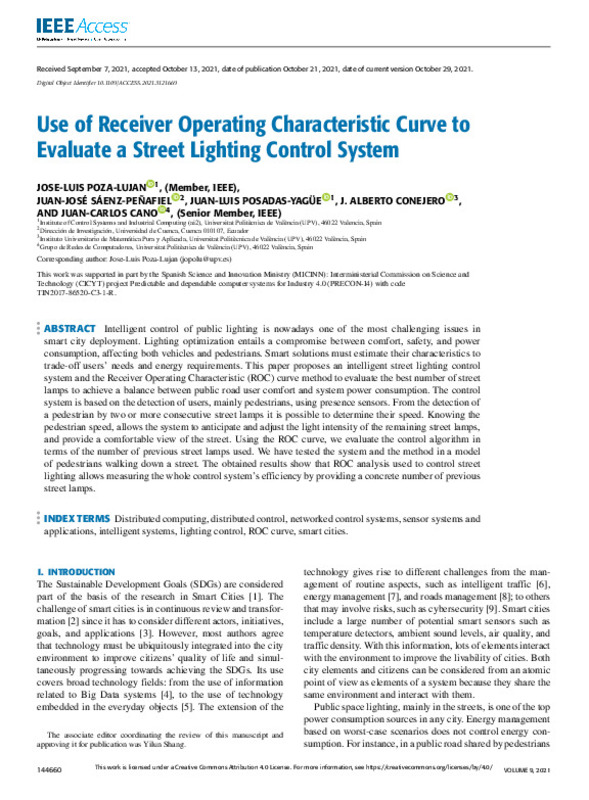JavaScript is disabled for your browser. Some features of this site may not work without it.
Buscar en RiuNet
Listar
Mi cuenta
Estadísticas
Ayuda RiuNet
Admin. UPV
Use of Receiver Operating Characteristic curve to evaluate a street lighting control system
Mostrar el registro sencillo del ítem
Ficheros en el ítem
| dc.contributor.author | Poza-Lujan, Jose-Luis
|
es_ES |
| dc.contributor.author | Sáenz-Peñafiel, Juan-José
|
es_ES |
| dc.contributor.author | Posadas-Yagüe, Juan-Luis
|
es_ES |
| dc.contributor.author | Conejero, J. Alberto
|
es_ES |
| dc.contributor.author | Cano, Juan-Carlos
|
es_ES |
| dc.date.accessioned | 2022-06-14T18:03:13Z | |
| dc.date.available | 2022-06-14T18:03:13Z | |
| dc.date.issued | 2021 | es_ES |
| dc.identifier.uri | http://hdl.handle.net/10251/183288 | |
| dc.description.abstract | [EN] Intelligent control of public lighting is nowadays one of the most challenging issues in smart city deployment. Lighting optimization entails a compromise between comfort, safety, and power consumption, affecting both vehicles and pedestrians. Smart solutions must estimate their characteristics to trade-off users' needs and energy requirements. This paper proposes an intelligent street lighting control system and the Receiver Operating Characteristic (ROC) curve method to evaluate the best number of street lamps to achieve a balance between public road user comfort and system power consumption. The control system is based on the detection of users, mainly pedestrians, using presence sensors. From the detection of a pedestrian by two or more consecutive street lamps it is possible to determine their speed. Knowing the pedestrian speed, allows the system to anticipate and adjust the light intensity of the remaining street lamps, and provide a comfortable view of the street. Using the ROC curve, we evaluate the control algorithm in terms of the number of previous street lamps used. We have tested the system and the method in a model of pedestrians walking down a street. The obtained results show that ROC analysis used to control street lighting allows measuring the whole control system's efficiency by providing a concrete number of previous street lamps. | es_ES |
| dc.description.sponsorship | This work was supported in part by the Spanish Science and Innovation Ministry (MICINN): Interministerial Commission on Science and Technology (CICYT) project Predictable and dependable computer systems for Industry 4.0 (PRECON-I4) with code TIN2017-86520-C3-1-R. | es_ES |
| dc.language | Inglés | es_ES |
| dc.publisher | Institute of Electrical and Electronics Engineers | es_ES |
| dc.relation.ispartof | IEEE Access | es_ES |
| dc.rights | Reconocimiento (by) | es_ES |
| dc.subject | Lighting | es_ES |
| dc.subject | Control systems | es_ES |
| dc.subject | Power demand | es_ES |
| dc.subject | Smart cities | es_ES |
| dc.subject | Lighting control | es_ES |
| dc.subject | Roads | es_ES |
| dc.subject | Intelligent sensors | es_ES |
| dc.subject | Distributed Systems | es_ES |
| dc.subject | ROC curve | es_ES |
| dc.subject | User comfort | es_ES |
| dc.subject.classification | MATEMATICA APLICADA | es_ES |
| dc.subject.classification | ARQUITECTURA Y TECNOLOGIA DE COMPUTADORES | es_ES |
| dc.title | Use of Receiver Operating Characteristic curve to evaluate a street lighting control system | es_ES |
| dc.type | Artículo | es_ES |
| dc.identifier.doi | 10.1109/ACCESS.2021.3121669 | es_ES |
| dc.relation.projectID | info:eu-repo/grantAgreement/AEI/Plan Estatal de Investigación Científica y Técnica y de Innovación 2013-2016/TIN2017-86520-C3-1-R/ES/SISTEMAS INFORMATICOS PREDECIBLES Y CONFIABLES PARA LA INDUSTRIA 4.0/ | es_ES |
| dc.rights.accessRights | Abierto | es_ES |
| dc.contributor.affiliation | Universitat Politècnica de València. Departamento de Matemática Aplicada - Departament de Matemàtica Aplicada | es_ES |
| dc.contributor.affiliation | Universitat Politècnica de València. Departamento de Informática de Sistemas y Computadores - Departament d'Informàtica de Sistemes i Computadors | es_ES |
| dc.description.bibliographicCitation | Poza-Lujan, J.; Sáenz-Peñafiel, J.; Posadas-Yagüe, J.; Conejero, JA.; Cano, J. (2021). Use of Receiver Operating Characteristic curve to evaluate a street lighting control system. IEEE Access. 9:144660-144675. https://doi.org/10.1109/ACCESS.2021.3121669 | es_ES |
| dc.description.accrualMethod | S | es_ES |
| dc.relation.publisherversion | https://doi.org/10.1109/ACCESS.2021.3121669 | es_ES |
| dc.description.upvformatpinicio | 144660 | es_ES |
| dc.description.upvformatpfin | 144675 | es_ES |
| dc.type.version | info:eu-repo/semantics/publishedVersion | es_ES |
| dc.description.volume | 9 | es_ES |
| dc.identifier.eissn | 2169-3536 | es_ES |
| dc.relation.pasarela | S\447967 | es_ES |
| dc.contributor.funder | AGENCIA ESTATAL DE INVESTIGACION | es_ES |
| dc.subject.ods | 09.- Desarrollar infraestructuras resilientes, promover la industrialización inclusiva y sostenible, y fomentar la innovación | es_ES |
| dc.subject.ods | 11.- Conseguir que las ciudades y los asentamientos humanos sean inclusivos, seguros, resilientes y sostenibles | es_ES |
| dc.subject.ods | 17.- Fortalecer los medios de ejecución y reavivar la alianza mundial para el desarrollo sostenible | es_ES |
| upv.costeAPC | 1491,98 | es_ES |








